MOJ
eISSN: 2576-4519


Review Article Volume 2 Issue 2
Department of Biomedical Engineering, The Catholic University, USA
Correspondence: Harold Szu, Department of Biomedical Engineering, The Catholic University, Wash DC, USA, Tel 2404 8268 89
Received: May 04, 2018 | Published: April 11, 2018
Citation: Szu H. Elucidation of human vision systems at microscopic level. MOJ App Bio Biomech. 2018;2(2):137–142. DOI: 10.15406/mojabb.2018.02.00056
Optical Engineer (OE) knows the “see no see” visibility test at various weather conditions, also wishes to understand the intrinsic Human Visual Systems (HVS) about contrast sensitivity function, but do not know where to begin to ask about. For example, why do cat have 4 times better night vision than human? The rich visual knowledge has distributed throughout the literature in the last Century, and not yet been reviewed in the OE book, e.g. how HVS at body temperature defeated the Quantum Mechanical Uncertainty Principle at the room temperature noise energy about or at human body temperature . How do we achieve in real time the scale invariant image processing of 1.5 millions pixels?
The human visual system (HVS) is the part of the central nervous system which gives human the ability to process visual detail. It detects and interprets information from visible color light to dark light build a gray scale representation of the surrounding environment. The visual system carries out a number of complex tasks, including the reception of light and the formation of monocular representations; the buildup of a binocular stereo perception from a pair of two eyes; assessing distances to and between objects; and guiding body movements in relation to the objects seen (Figure 1). In order to illustrate the self-assembly capability, Szu et al.1 considered experimentally a laser imaging experiment on a wet film that is made of bacteria rhodopsin (BR) molecules suspended in a diffusion-limited viscous medium.2,3 The 1981 Nobel Laureates in Physiology went to both Harvard Prof. David Hubel (passed away at 87 due to kidney failure) & Johns Hopkins Prof. Torsten Wiesel (8 years’ President of Rockefeller Univ 94 alive).4 Together they have discovered the simple cells for bars and complex cells for cross of cat vision. These open up the microscopic vision. It furthermore suggested the on-the-center and off the surround, so-called Mexican hat wavelet for multiple resolution analysis at feature extraction (cf. Sir John Daugman) at the retinal output. Then, the pathway of optical information is relayed through the Lateral Geniculate Nucleus (LGN) in the thalamus to the back of the head, cortex 17 area, with V1~V4 layers respectively give the color, edge, contour extraction Figure 1 picture is conveniently taken from Wikipedia; the explanation is synthesized from the open literature (Figure 2).
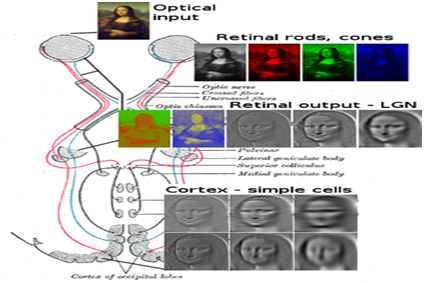
Figure 1 Human monocular and binocular visions begin with both eye optical lens and retina fovea where 6.5 million RGB color cones and 150 million dark light gray scale rods are distributed per eye. Each cone sensor has a nerve, and 100 rods are bundled together with at Ganglion integrator and the pass single nerve to back of the head.
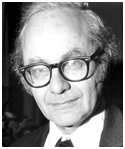

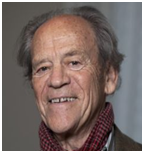
Figure 2 1981 Nobel Laureate Prof. David Hubel of Harvard Medical School & Prof. Torsten Wiesel of Johns Hopkins, now 94 years old together have discovered the simple cells for bars and complex cells for cross of detection in cat vision. This discovery began the microscopic molecular approach to HVS
We will now go into deeper at the microscopic vision at detector molecular level. Since early pioneers noticed the purple color in San Francisco bay area, it turned out to be bacteria rhodopsin that molecules instead of photo-detection, but inverse diffusion synthesize the solar energy. We have recently applied them to build real time holographic storage optical films.1 We pose seven questions at microscopically molecular level with terse answer for more details in the text as follows:
Ans: Single photon at body temperature.
Ans: Break off a no light dark current that n effect switch off the inhibition at the Ganglion neuron to fire 100 Hz back to the back of our head for detection tiger eye at cavern.
Ans: Increase the spatial uncertainty of 100 rods, to increase the sharp momentum of a single photon.
Ans: Separate the energy from information, and apply the negate the dark current to assert the converse logic
Ans: Dr. W Hagen at NIH/NEI in the mid of 21 Century.
Ans: A minimum of 100 to thousand photons.
Ans: a dropping of one of the seventh arm of rhodopsin molecule to increase the wavelength of detection becoming red color.
Semiconductor materials are made of small band gap “insulators.” The defining property of a semiconductor material is that it can be doped with impurities that alter its electronic properties in a controllable way. Complementary metal–oxide–semiconductor, abbreviated as CMOS is a technology for constructing integrated circuits (IC). It likes a triode in the insertion of impurity free electrons in the band gap material. For example, gallium arsenide (GaAs) has six times higher electron mobility than silicon, which allows faster operation; wider band gap, which allows operation of power devices at higher temperatures, and gives lower thermal noise to low power devices at room temperature; its direct band gap gives it more favorable optoelectronic properties than the indirect band gap material. The materials are solidified from the outside of the Earth iron core, which has been left from the natural nuclear decay with the heat. Metal Oxide is inert as a perfect insulator for a flat 2-D ground surface (Figure 4). On the other hand, biology choose Nitrogen & Carbone (which are chemically more active than metal oxide and silicon to build 3-D structure long Chain molecules of Carbone hydrates known as the sugars, as well as with the help of active Nitrogen to form the amino acids, protein, etc. to support life on the Earth.
To probe deeper of HVS, we need to see the cross section view to understand how the light from the left enters the pupil, the lens, the eyeball and by bounce it back from the back wall the eyeball. In so doing, we are not wearing a sun glass by the detector surface pointing from the left to the right receive the bounce back photons. Cat eye has better sensitivity than us because the cat. There are 6.5 million cones for color vision that are distributed uniformly on the fovea. There is 150 million rods non-uniformly exponential decay outward away from the optical axis to achieve scale invariant as follows. Thus, rhodopsin has the G-protein coupled receptor (GPCR) molecule, which appeared by dropping of one of 7 folds Carbon Hydrate Cis-Trans arms with longer distance producing the red color from green color. This fact is important for the survivor to be able seeing the red fruit color at far away distance that have more fructose to feed the offspring. While a dog does not have the red color rod but symbiotically following the human master who do, Homo-sapiens do because of more energy in ripen fruits (Figures 5-7). Furthermore, HVS can extract the invariant features beginning at the back of head Cortex 17 area: distributed in a polar exponential grids map to accomplish a gracefully degradation of the scaling law. A gracefully scale invariant is achieved by the massively parallel distributed (MPD) biological neural nets (BNN) as shown Eq(1) by the mathematic transform I/O=polar exponential sampling/uniform output as follows:
(1)
Where the scale gracefully degradation is due to “no representation, no taxation” all the bundle of rods must send s neural fiber from the integrator Ganglion to the Cortex 17, at the back of the head (Figure 1) (Figure 8). Polar Exponential Grid Architecture Eq(1) for the uniform sampling to logarithmic output to cortex 17 Eric L. Schwartz (born 1947) is Professor of Cognitive and Neurobiology at Boston University,; where in 1977, Schwartz pointed out that the hypercolumn model of Hubel and Weisel implied the existence of a periodic vortex like pattern of orientation singularities across the surface of visual cortex. Specifically, the angular part of the complex logarithm function, viewed as a spatial map provided a possible explanation of the hypercolumn structure, which in current language is termed the "pinwheel" structure of visual cortex. The scale is gracefully degradation only in the radial direction, e.g. the size Size=2 changes at the cortex only by (b) Image Feature Edge Extraction “on-center, off-surround” Mexican hat edge extraction has been emulated by multiple wavelet by the multiple layers Deep Learning; (c) NIH/NEI Dr. Hagins WA6 discovered at 1970 the dark current when no incoming photon to a rod. His laboratory at the NIH discovered that a single photon of light disrupts the “dark current” in the retina.
The illuminance of the eye at the Earth's surface varies by nearly 11 orders of magnitude during the normal day-night cycle; yet we are able to see differences between different luminous intensities nearly over this entire range (Rodieck, 1998; Fain et al., 2001; Arshavsky and Burns, 2012). Several mechanisms have evolved to allow the eye to function over a wide range of illuminance levels, so we can see the world around us. One of them is the action of iris muscles, which change the pupil diameter, and therefore are responsible for varying illuminance levels reaching the retina in a range of about two orders of magnitude. Although adjusting the pupil size to the changes in ambient light is important, it can only partly explain the ability of human vision to adjust to the wide range of light levels. Then, a size of two differences is merely Log 2 which is a minutia amount in the shift, so that the Homo sapiens ancestor can integrate the photons in the dark moonlight and yet be able to hit the prey right at the head to take cavern for mating. This is important to support Darwinian “fittest the survival” evolution principle defines the Natural Intelligent (Figure 9). The HVS cannot be mimicked by machine learning, since single photon detection cannot be simulated using a rule-based algorithm. Single photon detection is possible at room temperature despite the Quantum Mechanics Uncertainty Principle.5 It is possible based on the two clever logic principles discovered by (NIH/NEI) Dr. WC Hagines.6
Negate of the converse” logic
Dr. W. Hagine of NIH/NEI discovered that the break-off of the “dark current” that the sodium ion current circulates around the Rod detector with own energy budget under no light stimulus.
Quantum mechanical uncertainty principle
The spatial uncertainty of 100 rods in a bundle ∆x connected to the integration Ganglion cell and inhibits the firing of Ganglion cells. Then the single photon momentum uncertainty is property satisfies the Quantum Mechanics Uncertainty Principle
(2)
Furthermore, we separate the energy requirement from the information. A single photon has not enough energy to fire, a minimum of 100 photons are needed. The single photon can have EMF potential perturbed the membrane potential, as such the dark current is broken (i) negate the converse logic for no more dark current inhibiting the Ganglion cells, so that the information triggers the integration Ganglion cells using own energy to fire to the cortex 17 overcoming the thermal background noise energy about (1/37)eV, which is slightly larger than the room temperature (1/40)eV.
Separate the energy from the information
We add a third principle beyond Hagins by noting when a single photon does not have enough energy hitting at the rhodopsin molecule to activate at the room temperature; but it is sufficient to change the membrane potential that allows us to bypass the sodium ion current, by sensing the potential difference. So, we gain information despite having the energy to activate our detector, physics provides another means to take advantage of. These 100 rods are bundled to large size (mm) ganglions in the bottom with the inhibition ion dark current. When a single photon has broken the looping of dark current, then without the inhibition the ganglion can fire 100Hz to the cortex 17. This capability developed by Darwinian evolution “older & wiser” satisfies the Uncertainty Principle. It is important for our ancestors to be able to detect a single photon in a dark cavern from tiger eye. No artificial sensor has achieved the biosensor sensitivity capability. Accordingly, a minimum of 100 photons can statistically be enough to against the body temperature noise energy 1/50eV (Figure 10). Other important adaptive changes occur in photoreceptor cells in the retina, where the photons are absorbed, and first steps leading to visual perception take place. Upon the absorption of photons by the visual pigments in the photoreceptor outer segment, a cascade of events is triggered leading to the hyper-polarization of the photoreceptor plasma membrane, spreading rapidly to its synaptic terminal, where it leads to an inhibition of neurotransmitter release (Figure 10a). There are two types of photoreceptors in the retina: rods and cones. A dark-adapted rod can produce measurable responses upon absorption of a single photon; hyper-polarization of its plasma membrane and a decrease in an absolute value of the circulating current of cations.5 An increase in the numbers of absorbed photons by rods leads to an increase in the response amplitudes until reaching a saturation level, where the plasma membrane is maximally hyper-polarized, and the circulating current of cations is close to zero (Figure 10b).This is spatial across 100 rods connected the ganglion, which is firing the cortex 17. The location of which rod of the bundle is the uncertainty supported the sharp momentum P of a single photon: ; for mass-less photon, we have (Figure 11).
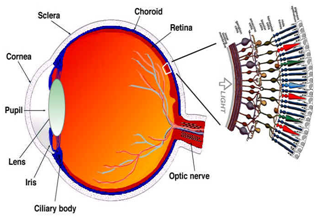
Figure 7 HVS Cross section view, the eye chooses to face backward to the incoming light, where all the connectivity cells are translucent to the RGB color lights. It is the reflected light from the end black mirror made of Pigment of Epithelium.

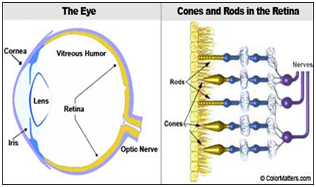
Figure 9 Cat Vision: The Pigment of Epithelium reflecting light for indirect exposure to the cones and rods; however cat has both layers including reflecting Pigment of Epithelium also distributed with rods without cones. It provides a factor of 2 in the amplitude and a factor 4 in the intensity detection. Thus cat eye must have very sensitive pupil dynamics to close under a stronger light.


Figure 10 Subsequently, the papers of Shannon were collected together as a 1948 book entitled "The Mathematical Theory of Communication" which is now is abbreviated as information theory. Shannon solved “the engineering problem of information”, namely transmission of a message in an efficient manner (minimizing the effect of channel noise and reception of the message). In the case of communication of information over a noisy channel, this abstract concept was made concrete Shannon's main result, the noisy-channel coding theorem showed that, in the limit of many channel uses, the rate of information that is asymptotically achievable is equal to the channel capacity, a quantity dependent merely on the statistics of the channel over which the messages are sent. By divorcing meaning from the engineering problem, the semantic problem was left to subsequent generations. Abstractly, information theory can be thought of as the means for resolution of the uncertainty of a signal in noise or minimizing the uncertainty of a problem by assigning a probability distribution to the data which is least informative with respect to the uncertainty (maximum entropy principle) which Shannon used to justify the use of “entropy” in his papers. Characterizing a problem in terms of the Shannon entropy is often sufficient, sometimes physical principles are needed as a separate exemplar.
The authors declare that there is no conflict of interest.

©2018 Szu. This is an open access article distributed under the terms of the, which permits unrestricted use, distribution, and build upon your work non-commercially.